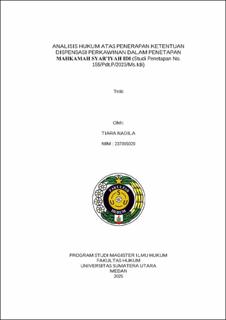| dc.description.abstract | The increasing number of marriage dispensation petitions indicates that although Law Number 16 of 2019 has raised the minimum marriage age to 19 years to protect children's rights and ensure physical, mental, and economic readiness for marriage, its implementation in practice remains ineffective. This phenomenon reflects that economic pressures, cultural norms, and social expectations continue to drive families to seek marriage dispensations, suggesting that social practices have yet to fully align with the law's intended objectives.
This study employs a normative juridical legal research method supported by empirical data and is descriptive-analytical in nature. Data were collected through both library and field research to obtain secondary data. The approaches used include statutory, case, and conceptual approaches.
The study concludes, first, that judges' decisions to grant marriage dispensations are influenced by internal factors such as social pressure and classical fiqh interpretations, and external factors such as low levels of education, economic hardship, and premarital pregnancy. This shows that marriage dispensation decisions are not purely legal in nature but are also shaped by socio-cultural conditions, necessitating stricter normative boundaries to ensure optimal child protection. Second, Article 7 paragraph (2) of the Marriage Law does not clearly define what constitutes an "urgent situation," leading to subjective interpretations and inconsistent rulings. Although Supreme Court Regulation (PERMA) No. 5 of 2019 provides guidelines, its implementation has not been optimal. Thus, the use of marriage dispensation must be restricted and treated strictly as a last resort (ultima ratio), prioritizing the principle of the best interest of the child. Third, in Case No. 155/Pdt.P/2023/MS.Idi, the granting of dispensation based on close personal relationships and fear of zina (premarital sexual acts) does not reflect an objectively defined "urgent situation." This highlights weak implementation of standards outlined in PERMA No. 5 of 2019 and underscores the need for a comprehensive evaluation of judicial reasoning. | en_US |


